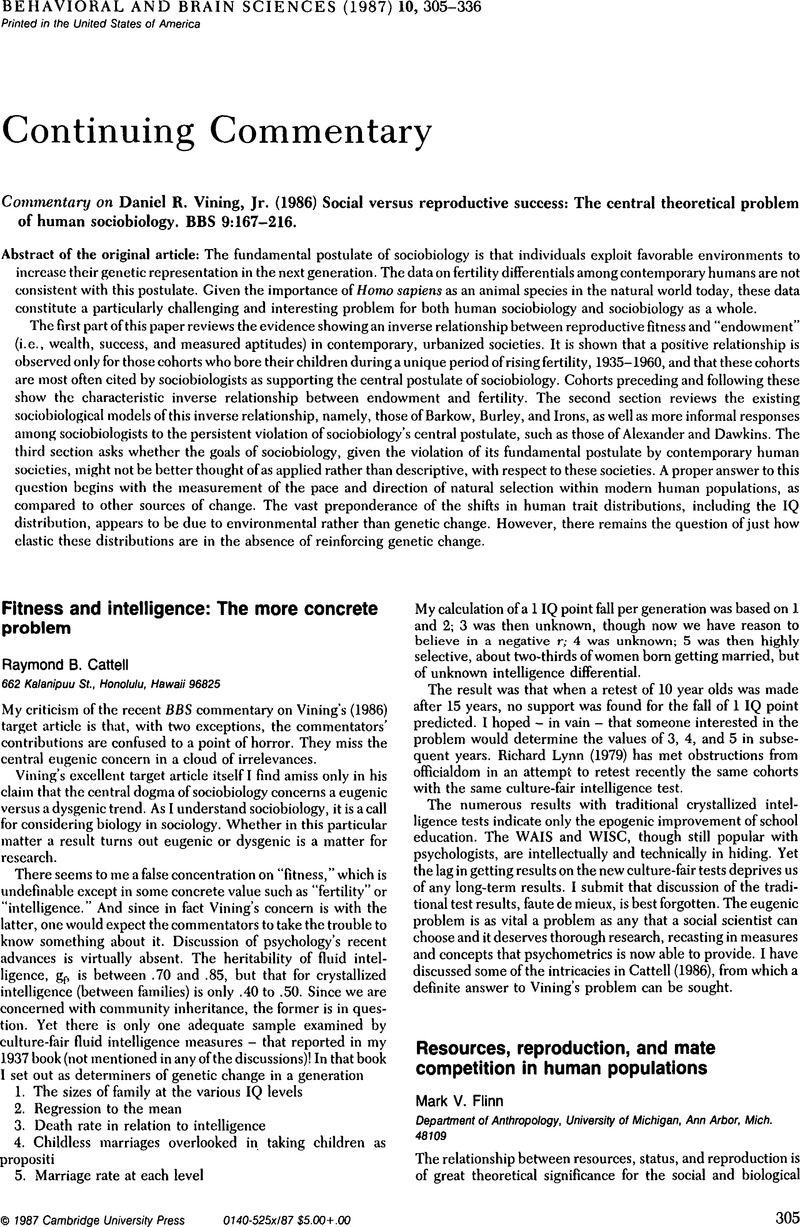Crossref Citations
This article has been cited by the following publications. This list is generated based on data provided by Crossref.
Turke, Paul W.
1990.
Which humans behave adaptively, and why does it matter?.
Ethology and Sociobiology,
Vol. 11,
Issue. 4-5,
p.
305.
Roberts, Joseph Palmer
1990.
The sociobiology of ethnocentrism in an Indian City.
Ethology and Sociobiology,
Vol. 11,
Issue. 6,
p.
465.
Broude, Gwen J.
1993.
Attractive single gatherer wishes to meet rich, powerful hunter for good time under mongongo tree.
Behavioral and Brain Sciences,
Vol. 16,
Issue. 2,
p.
287.
Hartung, John
1993.
Pérusse is right.
Behavioral and Brain Sciences,
Vol. 16,
Issue. 2,
p.
294.
Kenrick, Douglas T.
1993.
Do these sociobiologists have an answer for everything?.
Behavioral and Brain Sciences,
Vol. 16,
Issue. 2,
p.
299.
Wahlsten, Douglas
1993.
Sociobiology flops again.
Behavioral and Brain Sciences,
Vol. 16,
Issue. 2,
p.
310.
Betzig, Laura
1993.
Where are the bastards' daddies?.
Behavioral and Brain Sciences,
Vol. 16,
Issue. 2,
p.
284.
Flinn, Mark V.
1993.
Evolutionary psychology: Black box “mechanisms”?.
Behavioral and Brain Sciences,
Vol. 16,
Issue. 2,
p.
293.
Alcock, John
1993.
Exadaptations.
Behavioral and Brain Sciences,
Vol. 16,
Issue. 2,
p.
283.
Steven, David C.
1993.
“Potential” reproductions as an alternative proxy for reproductive success: A great direction, but the wrong road.
Behavioral and Brain Sciences,
Vol. 16,
Issue. 2,
p.
307.
Mueller, Ulrich
1993.
Actual and potential reproduction: There is no substitute for victory.
Behavioral and Brain Sciences,
Vol. 16,
Issue. 2,
p.
301.
Dupré, John
1993.
Scientism, sexism and sociobiology: One more link in the chain.
Behavioral and Brain Sciences,
Vol. 16,
Issue. 2,
p.
292.
Dunbar, R. I. M.
1993.
On the evolution of alternative reproductive strategies.
Behavioral and Brain Sciences,
Vol. 16,
Issue. 2,
p.
291.
Irons, William
1993.
Monogamy, contraception and the cultural and reproductive success hypothesis.
Behavioral and Brain Sciences,
Vol. 16,
Issue. 2,
p.
295.
Simpson, Jeffry A.
1993.
Male reproductive success as a function of social status: Some unanswered evolutionary questions.
Behavioral and Brain Sciences,
Vol. 16,
Issue. 2,
p.
305.
Bookstein, Fred L.
1993.
Converting cultural success into mating failure by aging.
Behavioral and Brain Sciences,
Vol. 16,
Issue. 2,
p.
285.
Kaplan, Hillard
1993.
The problem of resource accrual and reproduction in modern human populations remains an unsolved evolutionary puzzle.
Behavioral and Brain Sciences,
Vol. 16,
Issue. 2,
p.
297.
Silverberg, James
1993.
The adaptiveness of imaginatively eliminating behaviors: Stripping the cultural varnish from the natural evolutionary woodwork.
Behavioral and Brain Sciences,
Vol. 16,
Issue. 2,
p.
304.
Mealey, Linda
1993.
Sociobiology or evolutionary psychology? The debate continues.
Behavioral and Brain Sciences,
Vol. 16,
Issue. 2,
p.
300.
Pérusse, Daniel
1993.
Human status seeking is a Darwinian adaptation.
Behavioral and Brain Sciences,
Vol. 16,
Issue. 2,
p.
312.



